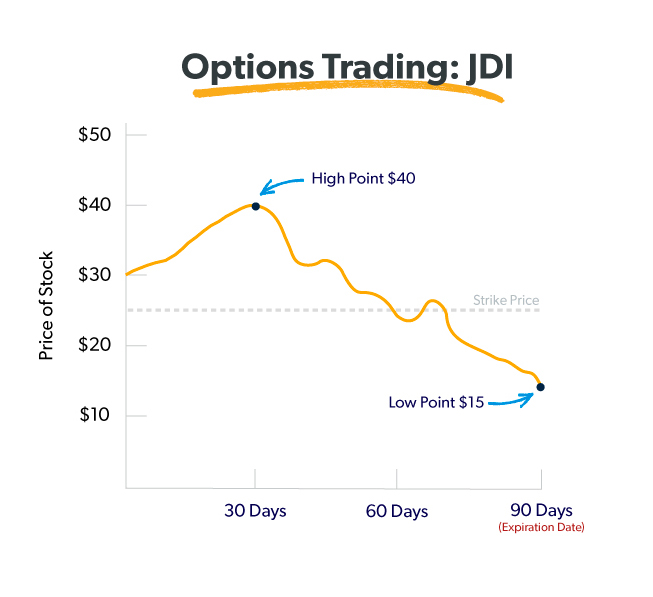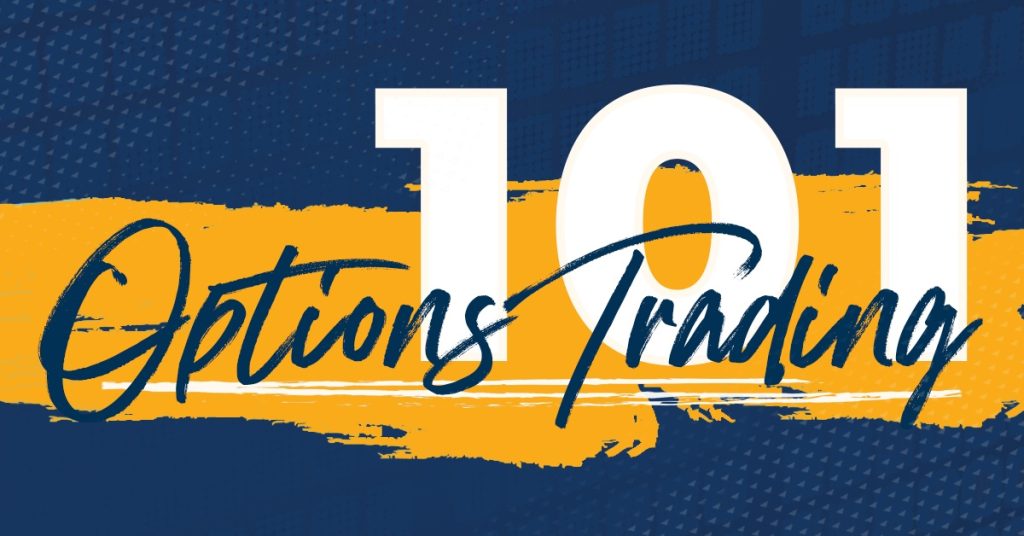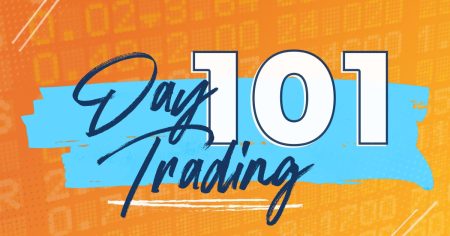When it comes to investing, there are good options, there are bad options . . . and then there’s options trading.
Many “do-it-yourself” investors looking for something to invest in besides stocks have tried their hand at buying and selling options as an alternative. In fact, 2018 was a record year for options trading with 20 million options contracts being bought and sold every day.1
Listen, we’re going to come right out and say that we’re not a fan of options trading. You’re basically putting your money on the line by rolling the dice on the success or failure of a company’s stock within a short window of time. It’s a dangerous game that will only leave you bruised and confused. Our advice? Steer clear!
But let’s take a closer look at options trading. First things first, we’ve got to start at the basics and understand what options are.
What Is an Option?
An option is a contract that gives you the right (but not the obligation) to buy or sell a particular stock at a specific price by a certain date. Just like you would buy stocks on the stock market, there’s an options market where you can go to buy and sell options.
Confused? Think of it this way: With an option, you’re simply trying to lock in the price of a stock you might want to buy or sell later for close to what it’s worth now. Depending on the type of option you get, you’re betting that the price of a particular stock will rise or fall within a certain amount of time.
There are only two types of options out there—call options and put options (also known as just “calls” and “puts”):
- Call options give you the opportunity to buy shares of a particular stock at a set price within a certain time frame, which means they become more valuable if the stock’s value rises.
- Put options are the exact opposite. They give you the chance to sell shares of a particular stock at a set price within a certain time frame, which means the option becomes more valuable if the stock price falls.
With an option, you’re simply trying to lock in the price of a stock you might want to buy or sell later for close to what it’s worth now.
How Do Options Work?
Listen, there’s a lot of confusing jargon and lingo that can leave you scratching your head, but every option can be broken down into five pieces that will help you understand how they work.
Let’s break each one of those pieces down into bite-sized chunks:
- The stock the option is based on. Every option is based on some kind of asset, in most cases that means stocks. And an option usually represents 100 shares of a particular stock that the owner of the option can buy or sell while the option is still active (that’s called “exercising the option”).
- The type of option. Your option is either a call or a put—that’s it!
- The expiration date. Do you know what an option and a gallon of milk have in common? After a certain date, they’re both useless! Every option comes with an expiration date, but that date could be anywhere from a few days to a few years from the time you buy the option. You can buy or sell the stock the option is based on or sell the option to somebody else who wants to buy it (that’s options trading—more on that later) up until the expiration date. Once that date comes and goes, the option simply disappears.
- The “strike price.” If you choose to exercise the option, this is the price you’ll be able to buy or sell each share of the stock that the option is based on. If you have a call option with a strike price of $20 and the stock’s value rises to $45 per share, you’ll still be able to buy at $20. This also makes your option much more valuable on the options market!
- The premium (or per-share cost of the option). This is how much you’ll need to pay for the option. You might see an option listed for $10. But it’s not actually worth $10. Remember, each option represents 100 shares of a particular stock. That $10 is the per-share cost of the option. So in reality, you would multiply the price of the option by 100 to get your premium—which in this case is $1,000. That’s how much you would have to pay for the option.
What Is Options Trading?
Most people who own options almost never exercise their option to buy or sell the shares of stock that the option is based on before the expiration date. Instead, they basically buy an option with the goal of selling it before it expires in order to make a profit.
Market chaos, inflation, your future—work with a pro to navigate this stuff.
That’s options trading: You’re buying and selling options on the options market. It’s basically the same thing as stock trading—except instead of trading single stocks you’re swapping options instead. Options traders will try to buy an option and then sell it when it’s worth more than what they paid for it.
But here’s the big problem with options: If you have a call option and the stock price falls below the strike price (or the stock price rises above a put option’s strike price), the option becomes worthless. You can’t sell the option because it would be cheaper to simply buy the stock off the market at the lower price, and exercising your option is pointless for the same reason. Once the expiration date comes and goes, the option simply disappears and you basically threw away whatever premium you paid to buy the option. Ouch!
That’s options trading: You’re buying and selling options on the options market. It’s basically the same thing as stock trading—except instead of trading single stocks you’re swapping options instead.
How Does Options Trading Work?
The best way to help you understand how options trading works is with an example. Let’s say Heather wants to buy a call option for John Doe Industries stock—JDI, for short. JDI stock is currently worth $30 per share, and Heather is pretty sure that its stock value is going to rise over the next few months.
She finds a call option for John Doe Industries stock with a strike price of $25 and an expiration date three months from now. The price of the option is listed at $5. Remember, options represent 100 shares of stock, so Heather needs to pay a $500 premium to buy the option—and she does.

One month later, JDI’s stock value shoots up to $40 per share. Here’s an important thing to remember: At the very least, the price of the option will always be worth the profit you could make if you exercised the option. Since the option’s strike price is $25, that means the call option has to be worth at least $15 (or have a premium of $1,500).
So, if Heather decided to sell her option now, she would make a $1,000 profit on her option. Not bad!
Instead, she decides to hold on to her option . . . for now. After all, there’s still almost two months left before the expiration date and Heather thinks JDI stock might grow even more during that time and give her an even bigger profit.
But Heather is wrong. One day after JDI stock hit that $40-per-share high, its stock price plummets and continues to drop like a rock for the next two months. The day before Heather’s option expires, JDI’s stock price is now worth a mere $15 per share—that’s $10 below the strike price!
With no time left and the stock price well below the strike price, her option is worth nothing. No one is going to buy her option since it’s cheaper to buy JDI stock on the open market, and it makes no sense for Heather to exercise her option . . . so she has no choice but to watch the option expire and disappear right along with her $500 initial investment.
The Bottom Line on Options Trading
Options trading is all about timing the market, and that is a dangerous game to be playing with your investing dollars. We put trading options in the same category as trading single stocks and other types of commodities like gold and precious metals—it’s highly volatile, very risky and extremely difficult to predict.
And most of the time, the gains made off of buying and selling options are small and you’ll have to pay capital gains taxes on those profits. It’s just not worth the headache!
On top of that, options traders don’t have the benefit of working directly with a financial advisor or investment professional to help them make important investment decisions. That means they are pretty much on their own trying to pick winners and losers in the stock market. When you make your decisions based on what someone posts on Reddit or on a news headline that will be irrelevant two days from now, that’s not a recipe for success!
Here’s the deal: Options traders are focused on finding quick wins in the short-term. We want you to be focused on building wealth in the long-term. The best way to do that is by investing in good growth stock mutual funds in your 401(k) and IRA. That’s the proven path that thousands of everyday millionaires have taken to build their net worth over time—there are no shortcuts!
Work With an Investment Professional
If you’re ready to start saving for retirement and invest in your future, you need to work with an investment professional who can help you come up with a plan to build wealth for the long haul.
Our SmartVestor program can connect you with an investment pro in your area who will sit down with you and walk you through your investing options so that you can make the best decision for your future.
Find a SmartVestor Pro today!
This article provides general guidelines about investing topics. Your situation may be unique. To discuss a plan for your situation, connect with a SmartVestor Pro. Ramsey Solutions is a paid, non-client promoter of participating Pros.
Read the full article here
















